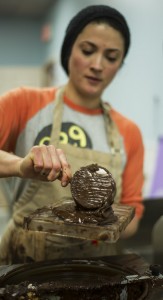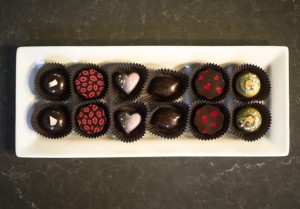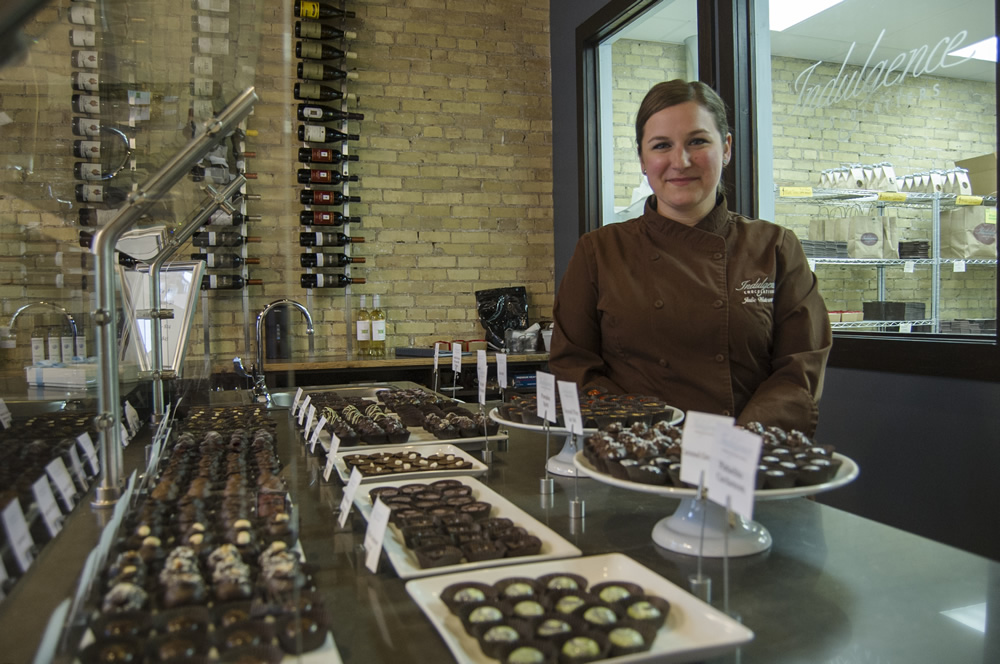Julie Waterman was backpacking through Europe on her honeymoon when she fell in love a second time.
It was outside a Dublin chocolate shop. “I immediately did a double-take, and I thought, ‘I have to go in there,’” she recalled. “And I tried a truffle, and I just thought, ‘Oh my, this is incredible.’”
Waterman was a senior at University of Wisconsin-Milwaukee when she turned that passion into a business, launching Indulgence Chocolatiers, which has stores in Shorewood and Milwaukee’s Walker’s Point neighborhood. A Wauwatosa store will open in May.
How was the chocolate in Europe different than in the U.S.? Why did it make such an impact on you?
I thought it was beautiful, artistic. There was innovation in the flavors, and it put a really personal connection onto the product.
I think in America, we consume a large quantity, but not necessarily good quality chocolate.

Mariana Cyr, of Indulgence Chocolatiers, pours melted chocolate into a mold to make sweet art. (Photo by Kenny Yoo)
You were studying music education at UWM. How did you decide to change paths?
It was heartbreaking decision. I talked with my faculty members. I talked with my family. It was tough because everything I had done in my life led up to the decision of a music education degree, and becoming a music teacher. It was the reason I joined the Army, so I could afford to go to school. And to give that up, I did not take that lightly at all. But I looked at the situation, and I thought, “If I don’t try this, I will always wonder.”
You talked to your professors? What did they think of your decision?
What was great about my professors, and two of them in particular, is that they understood that they were there as mentors, and that was regardless of whether it was that traditional track toward a career I went to school for, or if it was taking me in a slightly different direction. It was really cool that they realized there was value in my degree even if I didn’t use it for its intended purpose.
Do you think there is value in your degree?
Oh, absolutely. … I was preparing to be a teacher, well, so much of what I do is educating people about our chocolate, our company and what makes us different. I am using that portion of my degree all the time. I know music is a different art, but it still gave me that appreciation for art, and all forms of it, and I think what we do is artistic.
How did you learn to make the chocolate?

Indulgence Chocolatiers’ Valentine’s Day collection, with citrus basil, rose water pistachio, Banana’s Foster, balsamic fig, smoky pomegranate and ginger, passion fruit, caramel truffles.” (Photo by Kenny Yoo)
I’m completely self-taught; all of our current chefs are professionally trained pastry chefs. It was a lot of trial and error. I really enjoy studying something, and trying to understand the concepts of it, and then going out and trying it, and once you figure out a basic recipe, or basic food concept, you can start to play with it.
You have some amazing, exotic flavors — Thai peanut butter, sugar plum. How do you come up with your ideas?
Some concepts come from just eating dinner, and thinking, “I wonder what that would taste like with chocolate?” Balsamic fig was from a trip to Italy, where I just loved the combination of balsamic and fig, and I thought that would be so delicious in chocolate.
How do you draw those beautiful hearts and designs on the truffles?
Some of them that have more of a printed look are what we call transfer paper, which is a cocoa butter design on these acetate sheets that can be replicated over and over. Basically, you put it in a magnetic mold, and chocolate, when it’s in its tempered form, adheres to other cocoa butter. As it cools and solidifies, it simply lifts the design off the paper, and it’s part of the chocolate.
By M.L. Johnson

